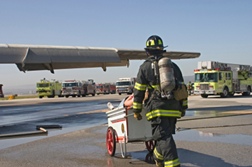 However, there was little the pilot could have done to prevent the passenger plane with 110 passengers from skidding off the runway after a gust of wind turned the jet into a veritable weathervane. The jet veered left of the runway at Denver International Airport on December 20, 2008, skidding across an open field before it broke into pieces and caught on fire. Flight attendants were credited with getting all passengers off the plane before the fire migrated into the passenger cabin.
However, there was little the pilot could have done to prevent the passenger plane with 110 passengers from skidding off the runway after a gust of wind turned the jet into a veritable weathervane. The jet veered left of the runway at Denver International Airport on December 20, 2008, skidding across an open field before it broke into pieces and caught on fire. Flight attendants were credited with getting all passengers off the plane before the fire migrated into the passenger cabin.While no one was killed, six were injured seriously and some remain emotionally traumatized. Mike Wilson, a software developer from Boulder, still suffers panic attacks whenever he encounters turbulence or a rough landing when flying.
According to a 7/13/10 report from the Associated Press (AP), the pilot of Continental Flight 1404 had stopped using the plane's right rudder about four seconds before a gust of wind slammed into the plane's tail at 52 miles per hour. The pilot had only the briefest of opportunities to correct the rudder and avoid the accident.
Still, investigators with the NTSB emphasize that there were numerous factors working against the pilot, namely:
Controllers told the pilot about a crosswind measuring 31 mph but failed to relay to the pilot there were also wind gusts. Gusts are very different from sustained winds.
READ MORE AIRPLANE CRASH LEGAL NEWS
The controllers reported to the pilot a crosswind under that benchmark by 7 mph—with no mention of wind gusts.
It was also noted that Continental's flight simulator trains pilots to deal with sustained crosswinds, but not wind gusts. That fact was discovered only as a result of the NTSB investigation.
The NTSB noted that pilots encounter crosswinds greater than 35 mph about once in 15,000 take-offs.
NTSB member Robert Sumwalt described the events leading up to the crash as "the perfect wind storm." The pilot would have had little opportunity to fly safely through it without incident. The NTSB appeared to lay the greater share of the blame on the failure to report important information to the pilot, prior to take-off.
